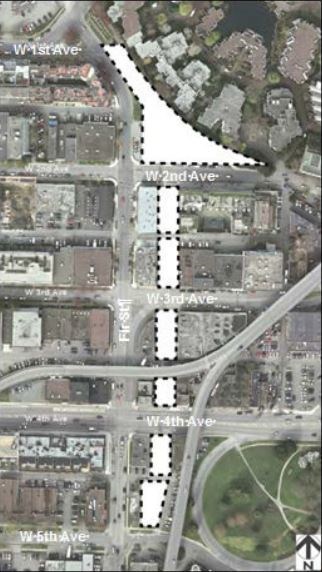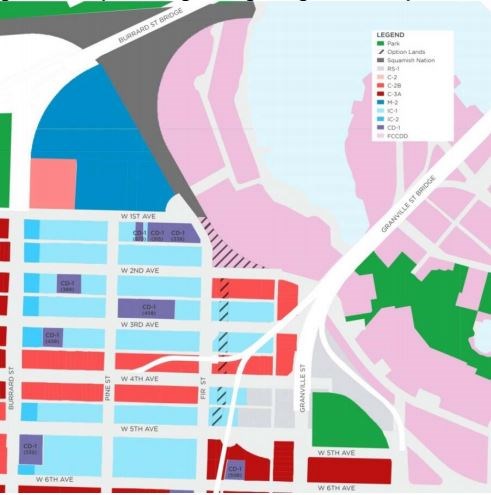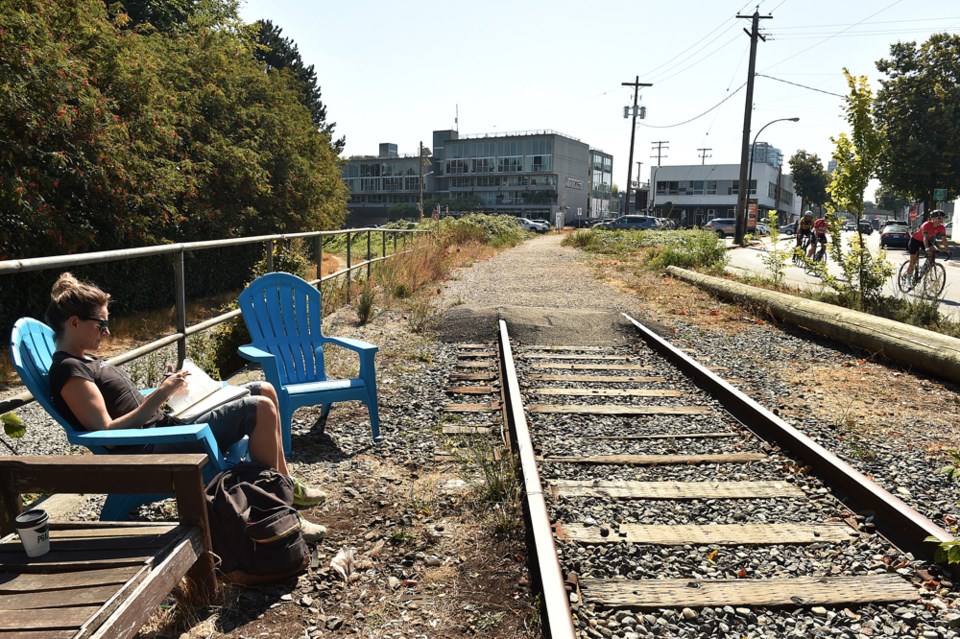A mayoral candidate for the ProVancouver Party is raising concerns about the possibility the City of Vancouver may end up re-selling parcels of Arbutus corridor known as the “Option Lands,” which are located at the north end of the route, back to CPR for $1 depending on the outcome of a public hearing Sept. 5.
The city bought the corridor from CPR in 2016 for $55 million. After months of consultation, city council unanimously approved the design vision for the transportation greenway on July 11. That decision triggered the need for Wednesday’s public hearing to amend the Arbutus Corridor Official Development Plan so that the Option Lands are removed from the ODP to meet conditions outlined in the purchase agreement. (Read the purchase agreement HERE)
ProVancouver's David Chen is questioning the deal, while city staff say the information about the Options Lands' clause has been publicly available since 2016.
Chen maintains it's not a good deal.
“We’ve got a housing crisis and we’ve also got an access to other amenities problem. Then we’ve got property that was purchased by the city under good faith and the taxpayers didn’t really know that there was a buy-back clause for $1. It doesn’t really make a lot of sense that the city should have gone into an agreement like that,” he told the Courier.
Twitter friends, we have more last minute fights to do. Council is trying to sell off part of the Arbutus corridor for $1 https://t.co/0S4TIhqIh1
— David Chen for Mayor (@DavidChenTweets) August 29, 2018
Join our voice at the public hearing Sept 5. and request to speak to stop this https://t.co/pIeWImFHtA @ProVancouverHQ
THE OPTION LANDS
The “Option Lands” include seven parcels measuring a total of about 60,000 square feet between West First and West Fifth avenues, which aren’t needed for the greenway.
Lon LaClaire, the City of Vancouver’s director of transportation, said the city anticipated the properties wouldn’t be needed for transportation purposes — walking, cycling and a future streetcar — before the purchase agreement was signed by the City of Vancouver and CPR in 2016.

“In advance of the purchase, we had done quite a bit of work looking along the corridor for what would be the basic needs for all the transportation components. These properties we saw as problematic, so those were identified quite up front,” he said.
The challenge with the properties, according to LaClaire, is they’re only about six to 12 metres from the existing intersections but the minimum distance needed is around 24 metres otherwise it creates safety concerns and is difficult to develop a design around.
Staff consider the Sept. 5 public hearing item a “housekeeping report” because the decision for where the transportation components will land has already been decided by council.
If council approves the amendment to remove the Option Lands from the Arbutus Corridor ODP, the properties will retain existing zoning.
Currently, three zoning designations relate to different parcels of the Option Lands. To the north, the zone is called False Creek Comprehensive Development District. That zoning doesn’t currently enable development.
To the south of that is C-2B, a mixed-use zone that includes commercial and residential. Further south, the parcels are primarily IC-1, which is a light-industrial zone. There are densities prescribed to each of those zones. For IC-1 it’s 3 FSR, for C-2B, it’s 2.5 FSR.

Any potential rezoning would be considered in a future public process. If the lands are rezoned, CPR has the option to re-purchase them from the city for $1, according to the purchase agreement. If CPR doesn’t exercise that option, it will share the proceeds of any sale of excess lands with the city.
Susan Haid, the city’s director of long range and strategic planning, said the purchase agreement has been publicly available since 2016 and the city's public engagement process for the corridor has been “very transparent” about the plans for the Option Lands, including during the most recent round of public consultation and in information outlined in the July design vision report, which also specifies plans for the connection of the greenway to False Creek.
“Throughout the process, and certainly in the last round of consultations prior to the design vision going to council, there was clearly information on that topic,” she said.
LaClaire echoed that point.
“I would just say that it shouldn’t be a surprise to anyone who was involved in the process. As Susan [Haid] said, we’ve had that purchase agreement available to anyone who wants to read it since the spring of 2016. The deal includes that clause, which is kind of fundamental to have arrived at that deal. So it shouldn’t come as a surprise to anyone is what I’d say if they’ve been following since day one, he said.
When asked if he thought the sale wouldn’t have gone through if the Option Lands clause wasn’t included, he said, “it’s entirely possible."
“The reality is when we were looking at the possibility of the purchase of the corridor, the notion of excess lands and the value of those was something that CP was very aware of. So a big component of the agreement is to understand what pieces of the property are required for the walking and cycling and the streetcar and, beyond that, what would be available for development.”
LaClaire said he doesn't know what the value of the properties is, but noted they’re narrow, which is always an issue when it comes to fitting parking and loading requirements.
Haid added: “Beyond recognizing they are extremely constrained for development, we haven’t assessed the development potential of them. We certainly acknowledge they all have existing zoning. There is the potential of assembly with adjacent properties… that would be something an owner may or may not want to explore.”
Developer and architect Michael Geller, who writes a column for the Courier, said the value of the lands for CPR will largely be determined by three factors that are in the city’s control: the zoning and form of development which the city ultimately approves for these lands; the adequacy of services — is there enough sewer and water capacity or will CP have to spend millions to upgrade; and how much the city charges CP in Community Amenity Contributions in return for rezoning
THE CRITICISM
News about the Sept. 5 public hearing sparked complaints about the Options Lands deal from some Vancouverites, including Chen and ProVancouver council candidate Rohana Rezel.
Chen said he hasn’t been following the Arbutus Greenway project personally but one of the party’s park board candidates has being following it and he brought the subject to Chen’s attention.
Chen questions the way the public is informed about such matters.
“The city has basically moved away from the concept of a town hall meeting with regards to public consultation and they’ve moved to this open house kind of process where people don’t necessarily know that it’s happening or they don’t know other people have concerns,” he said.
“Having a town hall meeting creates an environment where people who might be afraid to ask questions can actually ask questions because they hear other people asking the same thing. That’s where the information spreads a lot more. I’m not saying that the information was not actually available as much as the public was not actually very aware of the situation.”
Chan conceded the properties in question are in unusual spots, but he said if the city wasn’t going to use the land there should have been a pro-rate buy-back, not a $1 buy-back.
“I would have been pushing to make sure this was fair for both sides. If you look at this, it doesn’t sound very fair…. Let’s be serious, the time in between when [it] was purchased and now, the property has appreciated. So even if they have a buy-back on a pro-rate based on the original value, they’ve still got a deal. But here we’ve got the city buying it and they’re walking away from property and they’re not getting any compensation for it other than $1.”
Chen isn’t the only one who’s posted reactions on social media about the public hearing.
Current NPA park board commissioner Sarah Kirby-Yung, who’s running for a council seat in October’s civic election, wrote this tweet: “Why sell part of #ArbutusGreenway lands not determined to be in ‘transportation corridor’ at all? If agreement City struck with CPR precludes City developing it, why not keep land for park & green space??Keep as public amenity to support liveability as city densifies.”
That sparked a response from outgoing NPA Coun. George Affleck who responded to Kirby-Yung by defending the purchase agreement. “To secure the massive greenway and as a way to keep the price from escalating beyond what taxpayers could afford or support, the city struck a balanced deal for all of Vancouver. I supported it,” he wrote.
Why sell part of #ArbutusGreenway lands not determined to be in ‘transportation corridor’ at all? If agreement City struck with CPR precludes City developing it, why not keep land for park & green space??Keep as public amenity to support liveability as city densifies. #VanPoli https://t.co/y7ebYOddgR
— Sarah Kirby-Yung, mba 楊瑞蘭 (@sarahkirby_yung) September 5, 2018
Hey @CityofVancouver sell it to the Vancouver @ParkBoard for a dollar we can use more Park Space in our city and know how to build great parks https://t.co/HuA3G9bSlz
— John Coupar (@JohnCCoupar) September 5, 2018
The public hearing on the amendments to the Arbutus Corridor Official Development Plan is at 6 p.m., Sept. 5. It’s the fifth item on the agenda. As of early Wednesday morning, eight people had signed up to speak.
@naoibh



